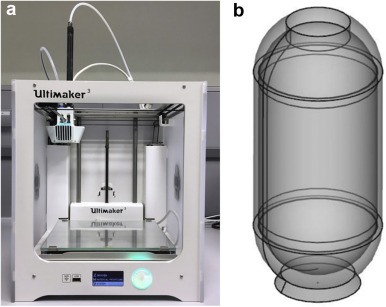In Vitro and In Vivo Evaluation of 3D Printed Capsules with Pressure Triggered Release Mechanism for Oral Peptide Delivery

In this study a 3D printed capsule designed to break from the physiological pressures in the antropyloric region was evaluated for its ability to deliver the synthetic octapeptide octreotide in beagle dogs when co-formulated with the permeation enhancer sodium caprate. The pressure sensitive capsules were compared to traditional enteric coated hard gelatin capsules and enteric coated tablets. Paracetamol, which is completely absorbed in dogs, was included in the formulations and used as an absorption marker to give information about the in vivo performance of the dosage forms. The pressure sensitive capsules released drug in 50% of the dogs. In the cases where drug was released, there was no difference in octreotide bioavailability or Cmax compared to the enteric coated dosage forms. When comparing all dosage forms, a correlation was seen between paracetamol Cmax and octreotide bioavailability, suggesting that a high drug release rate may be beneficial for peptide absorption when delivered together with sodium caprate. Continue reading here
Staffan Berg, Julius Krause, Anders Björkbom, Katrin Walter, Said Harun, Andreas Granfeldt, David Janzén, Sandro Filipe Nunes, Malin Antonsson, Natalie Van Zuydam, Stanko Skrtic, Andreas Hugerth, Werner Weitschies, Nigel Davies, Bertil Abrahamsson, Christel A.S. Bergström, In Vitro and In Vivo Evaluation of 3D Printed Capsules with Pressure Triggered Release Mechanism for Oral Peptide Delivery, Journal of Pharmaceutical Sciences, Volume 110, Issue 1, 2021, Pages 228-238, ISSN 0022-3549,
Conclusions
In this study the pressure sensitive capsules that did release drug performed similarly as the traditional enteric coated dosage forms in terms of octreotide bioavailability and Cmax. However, the pressure sensitive capsules did not release drug in 50% of the subjects which merits further attention. It is possible that a trigger pressure for release of less than 300 mbar is needed for optimal in vivo performance in dogs. This work confirms the usefulness of paracetamol as a well absorbed marker compound when performing absorption studies on peptides and other poorly absorbed compounds to distinguish between effects of drug release and permeation. Finally, high drug release rate proved beneficial for octreotide absorption, as seen in the correlation between octreotide bioavailability and paracetamol Cmax.
Materials
Paracetamol, fluorescein-sodium, sodium chloride, trifluoroacetic acid, formic acid and acetonitrile were purchased from Sigma-Aldrich (St. Louis, MO, USA). Phosphate buffered saline (PBS) was purchased from Life Technologies Limited (Paisley, UK, USA). Hydrochloric acid and tri-sodium phosphate dodecahydrate was purchased from Merck KGaA (Darmstadt, Germany). Sodium caprate was purchased from Finar chemicals (Ahmedabad, India). Octreotide was purchased from Polypeptide Laboratories (Ambernath, India). Mannitol (Pearlitol 100 SD, Roquette, France) and Eudragit L30D-55 (Evonik industries AG, Essen, Germany) were kind gifts from AstraZeneca R&D Gothenburg, Sweden. Eudragit® RS PO for Hot Melt Extrusion of filaments was gratefully donated by Evonik (Germany). Polylactic acid (PLA) filament for capsule sealing was purchased from Formfutura, (Formfutura Easyfil PLA, Nijmegen, Netherlands). All solvents used in the bioanalysis where LC-MS grade (Thermo Fisher Scientific, Waltham, MA, USA) and water was purified with a Milli-Q purification system.

